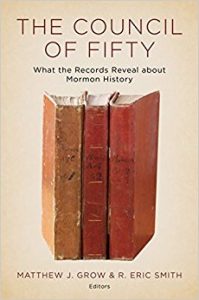Title: The Council of Fifty: What the Records Reveal About Mormon History
Editors: Matthew J. Grow and R. Eric Smith
Publisher: Brigham Young University, Provo, Utah
Year published: 2017
Number of pages: 201
Binding: Hardback
Price: $21.99
Reviewed by Dale E. Luffman for the Association for Mormon Letters
Research and study of the Council of Fifty, a confidential and rather secretive group formed three months prior to the death of Joseph Smith, Jr., has exploded in recent years. A leadership group brought together and functioning under Smith’s leadership for a short time, and then under the leadership of Brigham Young, operated as a significantly influential ecclesiastical and governing body from March 1844 to January 1846. As the Joseph Smith Papers Project has led to the publication of many documents of the early church, the recent publication of the Council of Fifty minutes, a rich and fascinating record of Council discussions, deliberations, and decisions, has added great value and significance to the project.
The Council of Fifty minutes had been much discussed but little understood until their release from the LDS Archives for careful and critical study. Now an integral part of the Joseph Smith Papers Project since 2016, the texts are available to the public. This is significant. However, being available does not necessarily mean that the texts are easily understandable.
That is where this volume, The Council of Fifty: What the Records Reveal about Mormon History, comes in. The fifteen essays make accessible an overwhelming and daunting text reflected in the commentators writing about the discussions, deliberations, and decisions of the Council of Fifty and the impact that this Council would have on the LDS Church as it journeyed West.
It appears that the editors of this 201 page volume have targeted an broader audience than that of the college of scholars, addressing the book’s essays to a more general public, mostly composed by the LDS community. That is to be commended! The editors have drawn commentary from a competent corps of LDS scholars, with some very recognizable names — Richard Bennett, Richard Bushman, Patrick Mason, and Paul Reeve, with co-editors Matthew Grow and Eric Smith also making contributions to the volume.
A thoughtful, well-written introduction meets the reader, extending an invitation into a provocative, understandable commentary on the various topics and discussions associated with the Council of Fifty minutes provided by William Clayton’s compilation efforts. The titles of the essays serve as the titles of the chapters of the book and provide for a splendid survey of the document being reviewed and commented upon. The chapter titles are instructive, including: The Separatist Impulse in the Nauvoo Council of Fifty; Injustices Leading to the Creation of the Council of Fifty; The Council of Fifty and Joseph Smith’s Presidential Ambitions; God and the People Reconsidered: Further Reflections on Theodemocracy in Early Mormonism; American Indians and the Nauvoo-Era Council of Fifty; ‘With Full Authority to Build Up the Kingdom of God on Earth’: Lyman Wight on the Council of Fifty; and nine others. The Council of Fifty and the Search for Religious Liberty concludes this splendid collection of essays.
Each of the commentators were asked to consider a basic question regarding their contribution to the volume, and that was: “How do the Council of Fifty minutes change our understanding of Mormon history? In other words, why do they matter?” (page xii). This important basic question provided for coherence and focus that is invaluable to the volume and contributed immensely to the readability of the work.
One of the things that I had wished would have been given attention in the development of this volume would have been the inclusion of non-LDS scholars and historians in the authorship of at least several of the essays. The volume is ghettoized by its exclusion; it did not need to be as exclusive as it appears to be. Voices of several standing outside the LDS community would have added credibility to an honest appraisal of the Council of Fifty Minutes. Would it have been too much to have been open to such an interfaith conversation? I think not.
The essays of this volume have the potential of illuminating this unique period of Mormon history as the authors narrate and analyze the Council of Fifty Minutes, shaping an understanding of not only the struggles of a community in the midst of crisis, but also a bit of Mormon history in the midst of the events of American history itself. This volume will prove to be an invaluable asset to a broad audience of Latter-day Saints and those interested in the history of the American West in the mid-1800’s. Its length and its concise treatment of the topic commends itself to a broad readership. A fine introduction to the Council of Fifty minutes.

